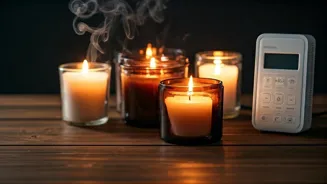The Scented Culprit
Scented candles, while seemingly harmless, often contain a cocktail of chemicals that release pollutants when burned. These candles often use paraffin
wax, a byproduct of petroleum refining, which releases volatile organic compounds (VOCs) like benzene and toluene when burned. These VOCs are known carcinogens and can contribute to indoor air pollution. The fragrances themselves, often synthetic, can trigger allergic reactions and respiratory problems for some individuals. Studies have shown that these chemicals can linger in the air long after the candle has been extinguished. The cumulative effect of repeated exposure can be significant, particularly for those with existing respiratory conditions like asthma or allergies. The type of wick also plays a role; some older candles used wicks with lead cores, further adding to the potential health risks.
Air Quality Concerns
The burning of scented candles significantly affects indoor air quality, often worsening it. The primary issue is the release of particulate matter, tiny particles that can penetrate deep into the lungs and cause inflammation and other health problems. The synthetic fragrances in these candles can also react with other chemicals in the air, forming secondary pollutants that can further degrade indoor air quality. Regular use of scented candles can lead to a buildup of these pollutants, making the air inside your home less healthy than the air outdoors. Moreover, the confined space of a home exacerbates the effects, as the pollutants are not easily dispersed. If you have pets or young children, they are even more susceptible to the harmful effects of poor air quality caused by the candles.
Respiratory Risks Explained
The chemicals released by burning scented candles can irritate the respiratory system. This irritation can manifest in various ways, from mild symptoms like coughing and sneezing to more severe reactions, particularly in those with asthma or allergies. VOCs and particulate matter can trigger asthma attacks and exacerbate existing respiratory conditions. The fragrance chemicals themselves can cause allergic reactions, leading to symptoms like runny nose, watery eyes, and difficulty breathing. Over time, chronic exposure to these pollutants can lead to a heightened sensitivity to other irritants and potentially contribute to the development of respiratory illnesses. To ensure respiratory health, it is essential to be mindful of indoor air quality and the products we use.
Choosing Safer Options
Fortunately, there are many alternatives to scented candles that allow you to enjoy a pleasant ambiance without compromising your health. Soy wax and beeswax candles are excellent choices. These waxes burn cleaner, releasing fewer pollutants, and often contain natural fragrances derived from essential oils. Essential oil diffusers are another safe option. These devices use water and essential oils to disperse fragrance into the air, without any burning or release of harmful chemicals. You can also consider using unscented candles made from natural waxes, combined with other elements to add to your home's atmosphere, such as diffusers with pleasant aromas or even the simple addition of fresh flowers and plants. Prioritizing natural and non-toxic options makes your home environment healthier.
Alternatives: Key Details
When choosing safer alternatives, consider several details. Look for candles made from natural waxes like soy, beeswax, or coconut wax, as these generally burn cleaner. Check the ingredients of any candle for synthetic fragrances, and opt for those scented with essential oils instead. Ensure the candle uses a lead-free wick; these are now standard in most well-made candles. For diffusers, research the essential oils you plan to use to ensure they are safe and appropriate for your needs. Choose products from reputable brands that prioritize product safety and transparency. A few examples of fragrances that are less likely to trigger reactions are tea tree, lavender, and eucalyptus. By following these guidelines, you can enjoy a fragrant and healthy home environment.









